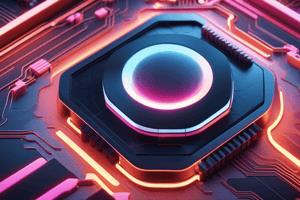Podcast
Questions and Answers
The processor is referred to as the Central Processing Unit (CPU)
The processor is referred to as the Central Processing Unit (CPU)
True (A)
Main Memory is non-volatile, meaning its contents are retained even when the computer is shut down.
Main Memory is non-volatile, meaning its contents are retained even when the computer is shut down.
False (B)
System Bus is responsible for communication among processors, main memory, and I/O modules.
System Bus is responsible for communication among processors, main memory, and I/O modules.
True (A)
A Microprocessor consists of multiple sockets, each containing a single processor.
A Microprocessor consists of multiple sockets, each containing a single processor.
The Processor fetches an instruction from memory during the Instruction Execution phase.
The Processor fetches an instruction from memory during the Instruction Execution phase.
Interrupts are used to speed up the processor utilization by eliminating the need for any pauses during I/O operations.
Interrupts are used to speed up the processor utilization by eliminating the need for any pauses during I/O operations.
In a symmetric multiprocessor system, each processor has its own separate main memory.
In a symmetric multiprocessor system, each processor has its own separate main memory.
Cache size has no impact on the performance of a computer system.
Cache size has no impact on the performance of a computer system.
Secondary memory is also known as volatile memory.
Secondary memory is also known as volatile memory.
Multicore computers combine multiple processors on separate pieces of silicon.
Multicore computers combine multiple processors on separate pieces of silicon.
Write policy dictates when the memory read operation takes place.
Write policy dictates when the memory read operation takes place.
The Memory Hierarchy emphasizes slower capacity and higher access speed.
The Memory Hierarchy emphasizes slower capacity and higher access speed.
A priority scheme is used in one of the approaches to handle multiple interrupts.
A priority scheme is used in one of the approaches to handle multiple interrupts.
Symmetric Multiprocessors (SMP) have processors that cannot perform the same functions.
Symmetric Multiprocessors (SMP) have processors that cannot perform the same functions.
The block size determines which cache location the block will occupy.
The block size determines which cache location the block will occupy.
Incremental Growth in SMP systems means adding more processors halts the machine.
Incremental Growth in SMP systems means adding more processors halts the machine.
Flashcards are hidden until you start studying
Study Notes
- An operating system manages hardware resources, provides services to users, and controls memory and I/O devices.
- The basic elements of a computer system include the processor, main memory, I/O modules, and system bus.
- The microprocessor revolutionized computing by introducing desktop and handheld computing with fast processing speeds.
- The instruction execution process involves fetching instructions from memory, interpreting them, and executing required actions.
- Interrupts are used to improve processor utilization and handle slower I/O devices, allowing for efficient data processing.
- Memory hierarchy is essential to balance memory capacity, speed, and cost, with different levels optimizing performance.
- Secondary memory, like hard drives, complements main memory by storing program and data files, interacting with memory management hardware.
- Cache memory exploits locality of reference, storing frequently accessed data for faster retrieval, using strategies like mapping functions and replacement algorithms.
- Symmetric Multiprocessors (SMP) systems feature multiple processors sharing memory and I/O devices, controlled by an integrated operating system.
- Multicore computers integrate multiple processor cores on a single chip, enhancing performance with independent components like cache memory.
Studying That Suits You
Use AI to generate personalized quizzes and flashcards to suit your learning preferences.





